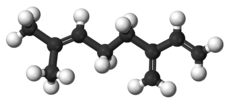- Myrcene
-
Myrcene[1] 
 7-Methyl-3-methylene-1,6-octadiene
7-Methyl-3-methylene-1,6-octadieneIdentifiers CAS number 123-35-3 
PubChem 31253 ChemSpider 28993 
KEGG C06074 
ChEBI CHEBI:17221 
ChEMBL CHEMBL455491 
Jmol-3D images Image 1 - CC(=CCCC(=C)C=C)C
Properties Molecular formula C10H16 Molar mass 136.23 g mol−1 Density 0.794 g/cm3 Melting point < -10 °C
Boiling point 166-168 °C[2]
 (verify) (what is:
(verify) (what is:  /
/ ?)
?)
Except where noted otherwise, data are given for materials in their standard state (at 25 °C, 100 kPa)Infobox references Myrcene, or β-myrcene, is an olefinic natural organic compound. It is classified as a hydrocarbon, more precisely as a monoterpene. Terpenes are dimers of isoprene and myrcene is one of the most important. It is a component of the essential oil of several plants including bay, ylang-ylang, wild thyme, and hops.[3][4] It is produced mainly semi-synthetically from myrcia, from which it gets its name. It is a key intermediate in the production of several fragrances. α-Myrcene is the name for the structural isomer 2-methyl-6-methylene-1,7-octadiene, which is not found in nature and is little used.[5]
Contents
Biosynthesis and production
Terpenes arise naturally from dehydration of terpenol geraniol. It could in principle be extracted from any number of plants, for example wild thyme, the leaves of which contain up to 40% by weight of myrcene. The current route to commercial samples is by the pyrolysis (400 °C) of pinene, which is obtained from turpentine.[5]
Use in fragrance industry
Myrcene is an important intermediate used in the perfumery industry. It has pleasant odor, but is rarely used directly. It is also unstable in air, tending to polymerize. Samples are stabilized by the addition of alkylphenols or tocopherol. It is thus more highly valued as an intermediate for the preparation of flavor and fragrance chemicals such as menthol, citral, citronellol, citronellal, geraniol, nerol, and linalool. Treatment of myrcene with hydrogen chloride gives geranyl chloride, neryl chloride, and linalyl chloride. Treatment of these compounds with acetate gives geranyl acetate, neryl acetate, and linalyl acetate, respectively. These esters are then hydrolyzed to the corresponding alcohols. Myrcene is also converted to myrcenol, another fragrance found in lavender, via uncatalyzed hydroamination of the 1,3-diene followed by hydrolysis and Pd-catalyzed removal of the amine.
As 1,3-dienes, both myrcene and mycenol undergo Diels-Alder reactions with several dienophiles such as acrolein to give cyclohexene derivatives that are also useful fragrances.[2]
Compendial status
Partial list of the plants that contain myrcene
As mentioned above, many plants contain myrcene, sometimes in very large amounts.[5]
- Houttuynia
- Mangoes
- Cannabis spp.
- Hops
- Lemon grass
- West Indian Bay Tree
- Verbena
- Mercia
See also
- Perfume allergy
References
- ^ Merck Index, 11th Edition, 6243
- ^ a b Karl-Georg Fahlbusch, Franz-Josef Hammerschmidt, Johannes Panten, Wilhelm Pickenhagen, Dietmar Schatkowski, Kurt Bauer, Dorothea Garbe, Horst Surburg “Flavors and Fragrances” in Ullmann's Encyclopedia of Industrial Chemistry 2002, Wiley-VCH, Weinheim. doi:10.1002/14356007.a11_141
- ^ Chyau, Charng-Cherng et al.; Mau, Jeng-Leun; Wu, Chung-May (1996). "Characteristics of the Steam-Distilled Oil and Carbon Dioxide Extract of Zanthoxylum simulans Fruits". Journal of Agricultural and Food Chemistry 44 (4): 1096–1099. doi:10.1021/jf950577d.
- ^ Glenn Tinseth, "Hop Aroma and Flavor", January/February 1993, Brewing Techniques. <http://realbeer.com/hops/aroma.html> Accessed July 21, 2010.
- ^ a b c Arno, B. and Leif, J., "Myrcene as a Natural Base Chemical in Sustainable Chemistry: A Critical Review", ChemSusChem, 2009, volume 2, pp. 1072-1095. doi:10.1002/cssc.200900186
- ^ The British Pharmacopoeia Secretariat (2009). "Index, BP 2009". http://www.pharmacopoeia.co.uk/pdf/2009_index.pdf. Retrieved 31 March 2010.
Categories:- Flavors
- Alkenes
- Hydrocarbons
- Perfume ingredients
- Monoterpenes
Wikimedia Foundation. 2010.
